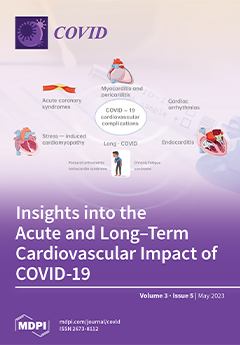Open AccessArticle
The Associations of Antihypertensive Medications, Steroids, Beta Blockers, Statins and Comorbidities with COVID-19 Outcomes in Patients with and without Chronic Kidney Disease: A Retrospective Study
by
Paul Kim, Vidhya Nadarajan, Maham Ahmed, Katerina Furman, Zoya Gurm, Priyanka Kale, Zaina Khoury, Sara Koussa, Dana LaBuda, Margo Mekjian, Pooja Polamarasetti, Leticia Simo, Charlotte Thill, Sophie Wittenberg, Sorabh Dhar and Dragana Komnenov
Viewed by 1450
Abstract
(1) Background: Data on COVID-19 outcomes and disease course as a function of different medications used to treat cardiovascular disease and chronic kidney disease (CKD), as well as the presence of different comorbidities in primarily Black cohorts, are lacking. (2) Methods: We conducted
[...] Read more.
(1) Background: Data on COVID-19 outcomes and disease course as a function of different medications used to treat cardiovascular disease and chronic kidney disease (CKD), as well as the presence of different comorbidities in primarily Black cohorts, are lacking. (2) Methods: We conducted a retrospective medical chart review on 327 patients (62.6% Black race) who were admitted to the Detroit Medical Center, Detroit, MI. Group differences (CKD vs. non-CKD) were compared using the Pearson χ
2 test. We conducted univariate and multivariate regression analyses for factors contributing to death during hospitalization due to COVID-19 (primary outcome) and ICU admission (secondary outcome), adjusting for age, sex, different medications, and comorbidities. A sub-analysis was also completed for CKD patients. (3) Results: In the fully adjusted model, a protective effect of ACEi alone, but not in combination with ARB or CCB, for ICU admission was found (OR = 0.400, 95% CI [0.183–0.874]). Heart failure was significantly associated with the primary outcome (OR = 4.088, 95% CI [1.1661–14.387]), as was COPD (OR = 3.747, 95% CI [1.591–8.828]). (4) Conclusions: Therapeutic strategies for cardiovascular disease and CKD in the milieu of different comorbidities may need to be tailored more prudently for individuals with COVID-19, especially Black individuals.
Full article





